人教版(2019)选择性必修第三册Unit1 Art Using Language整体阅读阅读技巧点拨课件(16张ppt)
文档属性
| 名称 | 人教版(2019)选择性必修第三册Unit1 Art Using Language整体阅读阅读技巧点拨课件(16张ppt) | 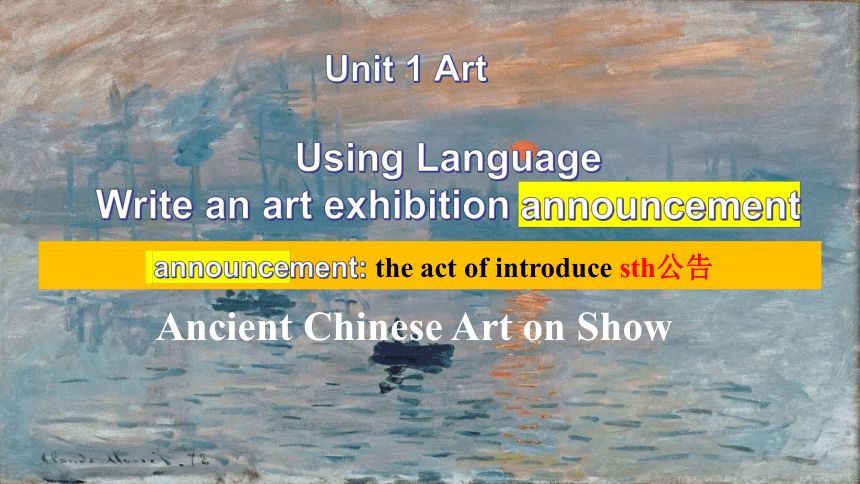 | |
| 格式 | zip | ||
| 文件大小 | 17.6MB | ||
| 资源类型 | 教案 | ||
| 版本资源 | 人教版(2019) | ||
| 科目 | 英语 | ||
| 更新时间 | 2022-02-23 22:05:36 | ||
图片预览


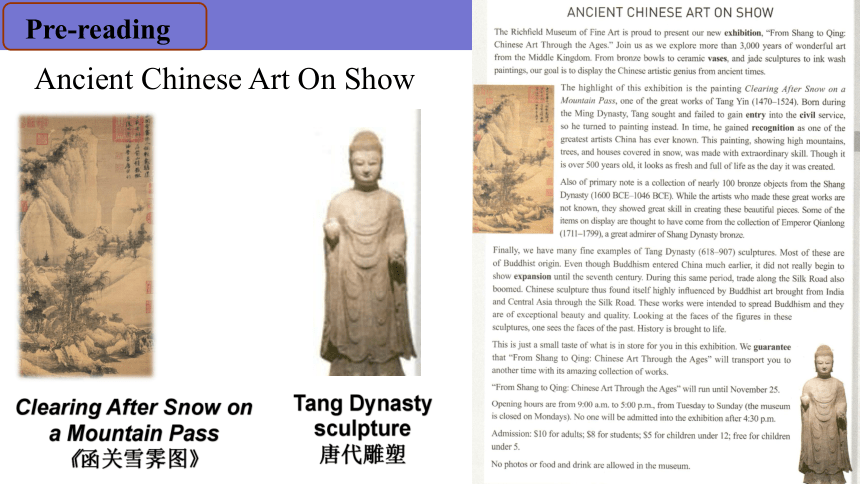
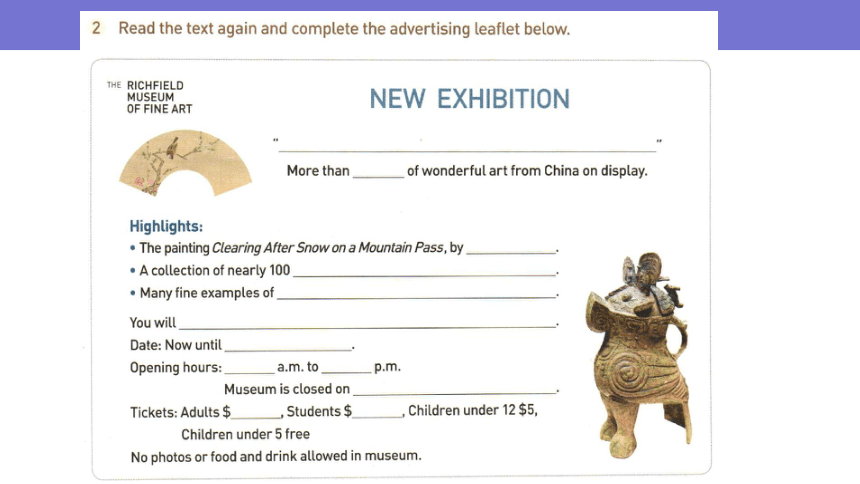
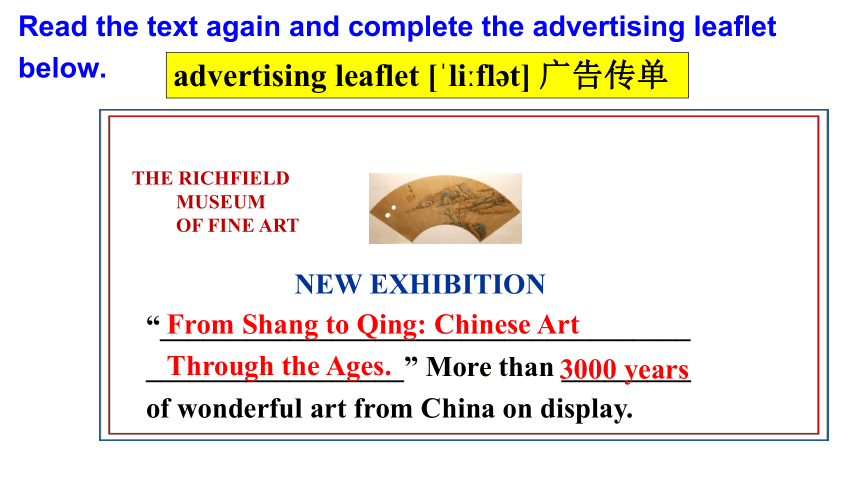
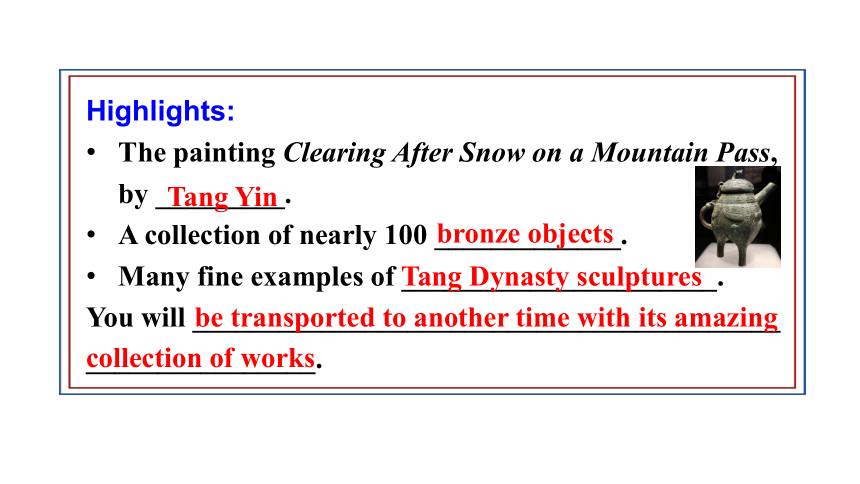

文档简介
(共16张PPT)
Unit 1 Art
Using Language
Write an art exhibition announcement
announcement: the act of introduce sth公告
Ancient Chinese Art on Show
词汇记忆(听--读--记)
1.n.展览;(技能、感情或行为的)表演
2. n.青铜;深红褐色 adj.青铜色的;深红褐色的
3.n.陶瓷制品;制陶艺术 4.n.花瓶;装饰瓶
5.adj.艺术的;艺术家的 6. n.加入;进入;参与
7. adj.国民的;民用的;民事的 8. n.承认;认出;赞誉
9. adj.佛教的 n.佛教徒 10. n. 佛教
11. n.扩张;扩展;扩大
12.赋予……生命;使……鲜活起来 ...
13.vt.保证;确保 n.保证;保修单;担保物
14. adj.当代的;现代的;属同时期的 n.同代人;同辈人
15. adj.值得……的;有价值的
16.值得
Pre-reading
Clearing After Snow on a Mountain Pass
《函关雪霁图》
Tang Dynasty sculpture
唐代雕塑
Ancient Chinese Art On Show
Read the text again and complete the advertising leaflet below.
NEW EXHIBITION
“_____________________________________
__________________” More than _________ of wonderful art from China on display.
THE RICHFIELD
MUSEUM
OF FINE ART
From Shang to Qing: Chinese Art Through the Ages.
3000 years
advertising leaflet [ li fl t] 广告传单
Highlights:
The painting Clearing After Snow on a Mountain Pass, by _________.
A collection of nearly 100 _____________.
Many fine examples of ______________________.
Tang Yin
bronze objects
Tang Dynasty sculptures
You will _________________________________________
________________.
be transported to another time with its amazing
collection of works
Date: Now until _____________.
Opening hours:________ a.m. to ______ p.m.
Museum is closed on ________.
Tickets: Adults $ _____, Students $ _____.
Children under 12 $5, Children under 5 free
No photos or food and drink allowed in museum.
November 25
9:00
5:00
Mondays
10
8
Part 1 (para1)
Part 2 (para2—4)
Part3 (para5)
Part 4 (Para6—9)
listen and sum up the main idea with each part.
ANCIENT CHINNESEART ON SHOW
The Richfield Museum of Fine Art is proud to present our new exhibition, “From Shang to Qing: Chinese Art Through the Ages.” Join us as we explore more than 3,000 years of wonderful art from the Middle Kingdom. From bronze bowls to ceramic vases, and jade sculptures to ink wash paintings our goal is to display the Chinese artistic genius from ancient times
Part 1 (para1) listen and get the main idea
ANCIENT CHINNESEART ON SHOW
The Richfield Museum of Fine Art is proud to present our new exhibition, “From Shang to Qing: Chinese Art Through the Ages.” Join us as we explore more than 3,000 years of wonderful art from the Middle Kingdom. From bronze bowls to ceramic vases, and jade sculptures to ink wash paintings our goal is to display the Chinese artistic genius from ancient times.
ANCIENT CHINNESEART ON SHOW
The Richfield Museum of Fine Art is proud to present our new exhibition, “From Shang to Qing: Chinese Art Through the Ages.” Join us as we explore more than 3,000 years of wonderful art from the Middle Kingdom. From bronze bowls to ceramic vases, and jade sculptures to ink wash paintings our goal is to display the Chinese artistic genius from ancient times
Part 1 (para1)
the main idea
An introduction of the exhibition
ANCIENT CHINNESEART ON SHOW
The Richfield Museum of Fine Art is proud to present our new exhibition, “From Shang to Qing: Chinese Art Through the Ages.” Join us as we explore more than 3,000 years of wonderful art from the Middle Kingdom. From bronze bowls to ceramic vases, and jade sculptures to ink wash paintings our goal is to display the Chinese artistic genius from ancient times.
The highlight of this exhibition is the painting Clearing After Snow on a Mountain Pass, one of the great works of Tang Yin (1470-1524). Born during the Ming Dynasty, Tang sought and failed to gain entry into the civil service, so he turned to painting instead. In time, he gained recognition as one of the greatest artists China has ever known. This painting, showing high mountains, trees, and houses covered in snow, was made with extraordinary skill. Though it is over 500 years old, it looks as fresh and full of life as the day it was created.
Also of primary note is a collection of nearly 100 bronze objects from the Shang Dynasty (1600 BCE-1046 BCE). While the artists who made these great works are not known, they showed great skill in creating these beautiful pieces. Some of the items on display are thought to have come from the collection of Emperor Qianlong(1711-1799), a great admirer of Shang Dynasty bronze Finally, we have many fine examples of Tang Dynasty(618-907)sculptures. Most of these are of Buddhist origin. Even though Buddhism entered China much earlier, it did not really begin to show expansion until the seventh century. During this same period, trade along the Silk Road also boomed. Chinese sculpture thus found itself highly influenced by Buddhist art brought from India and Central Asia through the Silk Road. These works were intended to spread Buddhism and they are of exceptional beauty and quality. Looking at the faces of the figures in these sculptures, one sees the faces of the past. History is brought to life.
Part 2 (para 2—4)
The highlight of this exhibition is the painting Clearing After Snow on a Mountain Pass, one of the great works of Tang Yin (1470-1524). Born during the Ming Dynasty, Tang sought and failed to gain entry into the civil service, so he turned to painting instead. In time, he gained recognition as one of the greatest artists China has ever known. This painting, showing high mountains, trees, and houses covered in snow, was made with extraordinary skill. Though it is over 500 years old, it looks as fresh and full of life as the day it was created.
Also of primary note is a collection of nearly 100 bronze objects from the Shang Dynasty (1600 BCE-1046 BCE). While the artists who made these great works are not known, they showed great skill in creating these beautiful pieces. Some of the items on display are thought to have come from the collection of Emperor Qianlong(1711-1799), a great admirer of Shang Dynasty bronze Finally, we have many fine examples of Tang Dynasty(618-907)sculptures. Most of these are of Buddhist origin. Even though Buddhism entered China much earlier, it did not really begin to show expansion until the seventh century. During this same period, trade along the Silk Road also boomed. Chinese sculpture thus found itself highly influenced by Buddhist art brought from India and Central Asia through the Silk Road. These works were intended to spread Buddhism and they are of exceptional beauty and quality. Looking at the faces of the figures in these sculptures, one sees the faces of the past. History is brought to life.
Part 2 (para 2—4)
the main idea
Highlights of the exhibition
Part3 (para 5)
This is just a small taste of what is in store for you in this exhibition. We guarantee that "From Shang to Qing: Chinese Art Through the Ages" will transport you to another time with its amazing collection of works.
Part3 (para 5)
This is just a small taste of what is in store for you in this exhibition. We guarantee that "From Shang to Qing: Chinese Art Through the Ages" will transport you to another time with its amazing collection of works.
the main idea
a brief summary of the exhibition
Part 4 (Para 6—9)
From Shang to Qing: Chinese Art Through the Ages " will run until November 25.
Opening hours are from 9: 00 a.m. to 5: 00 p. m, from Tuesday to Sunday ( the museum is closed on Mondays). No one will be admitted into the exhibition after 4: 30 p. m.
Admission: $10 for adults; $8 for students; $5 for children under 12; free for children under 5.
No photos or food and drink are allowed in the museum.
the main idea
matters needing attention about the exhibition
From Shang to Qing: Chinese Art Through the Ages " will run until November 25.
Opening hours are from 9: 00 a.m. to 5: 00 p. m, from Tuesday to Sunday ( the museum is closed on Mondays). No one will be admitted into the exhibition after 4: 30 p. m.
Admission: $10 for adults; $8 for students; $5 for children under 12; free for children under 5.
No photos or food and drink are allowed in the museum.
pre-writing
_________
__________
to the art exhibition
General
introduction
________ __________ of the exhibition
The highlights
__________ of
the exhibition
Attentions
Beginning
Body
Ending
Para1
Para2-4
Para5-9
Structure
Unit 1 Art
Using Language
Write an art exhibition announcement
announcement: the act of introduce sth公告
Ancient Chinese Art on Show
词汇记忆(听--读--记)
1.n.展览;(技能、感情或行为的)表演
2. n.青铜;深红褐色 adj.青铜色的;深红褐色的
3.n.陶瓷制品;制陶艺术 4.n.花瓶;装饰瓶
5.adj.艺术的;艺术家的 6. n.加入;进入;参与
7. adj.国民的;民用的;民事的 8. n.承认;认出;赞誉
9. adj.佛教的 n.佛教徒 10. n. 佛教
11. n.扩张;扩展;扩大
12.赋予……生命;使……鲜活起来 ...
13.vt.保证;确保 n.保证;保修单;担保物
14. adj.当代的;现代的;属同时期的 n.同代人;同辈人
15. adj.值得……的;有价值的
16.值得
Pre-reading
Clearing After Snow on a Mountain Pass
《函关雪霁图》
Tang Dynasty sculpture
唐代雕塑
Ancient Chinese Art On Show
Read the text again and complete the advertising leaflet below.
NEW EXHIBITION
“_____________________________________
__________________” More than _________ of wonderful art from China on display.
THE RICHFIELD
MUSEUM
OF FINE ART
From Shang to Qing: Chinese Art Through the Ages.
3000 years
advertising leaflet [ li fl t] 广告传单
Highlights:
The painting Clearing After Snow on a Mountain Pass, by _________.
A collection of nearly 100 _____________.
Many fine examples of ______________________.
Tang Yin
bronze objects
Tang Dynasty sculptures
You will _________________________________________
________________.
be transported to another time with its amazing
collection of works
Date: Now until _____________.
Opening hours:________ a.m. to ______ p.m.
Museum is closed on ________.
Tickets: Adults $ _____, Students $ _____.
Children under 12 $5, Children under 5 free
No photos or food and drink allowed in museum.
November 25
9:00
5:00
Mondays
10
8
Part 1 (para1)
Part 2 (para2—4)
Part3 (para5)
Part 4 (Para6—9)
listen and sum up the main idea with each part.
ANCIENT CHINNESEART ON SHOW
The Richfield Museum of Fine Art is proud to present our new exhibition, “From Shang to Qing: Chinese Art Through the Ages.” Join us as we explore more than 3,000 years of wonderful art from the Middle Kingdom. From bronze bowls to ceramic vases, and jade sculptures to ink wash paintings our goal is to display the Chinese artistic genius from ancient times
Part 1 (para1) listen and get the main idea
ANCIENT CHINNESEART ON SHOW
The Richfield Museum of Fine Art is proud to present our new exhibition, “From Shang to Qing: Chinese Art Through the Ages.” Join us as we explore more than 3,000 years of wonderful art from the Middle Kingdom. From bronze bowls to ceramic vases, and jade sculptures to ink wash paintings our goal is to display the Chinese artistic genius from ancient times.
ANCIENT CHINNESEART ON SHOW
The Richfield Museum of Fine Art is proud to present our new exhibition, “From Shang to Qing: Chinese Art Through the Ages.” Join us as we explore more than 3,000 years of wonderful art from the Middle Kingdom. From bronze bowls to ceramic vases, and jade sculptures to ink wash paintings our goal is to display the Chinese artistic genius from ancient times
Part 1 (para1)
the main idea
An introduction of the exhibition
ANCIENT CHINNESEART ON SHOW
The Richfield Museum of Fine Art is proud to present our new exhibition, “From Shang to Qing: Chinese Art Through the Ages.” Join us as we explore more than 3,000 years of wonderful art from the Middle Kingdom. From bronze bowls to ceramic vases, and jade sculptures to ink wash paintings our goal is to display the Chinese artistic genius from ancient times.
The highlight of this exhibition is the painting Clearing After Snow on a Mountain Pass, one of the great works of Tang Yin (1470-1524). Born during the Ming Dynasty, Tang sought and failed to gain entry into the civil service, so he turned to painting instead. In time, he gained recognition as one of the greatest artists China has ever known. This painting, showing high mountains, trees, and houses covered in snow, was made with extraordinary skill. Though it is over 500 years old, it looks as fresh and full of life as the day it was created.
Also of primary note is a collection of nearly 100 bronze objects from the Shang Dynasty (1600 BCE-1046 BCE). While the artists who made these great works are not known, they showed great skill in creating these beautiful pieces. Some of the items on display are thought to have come from the collection of Emperor Qianlong(1711-1799), a great admirer of Shang Dynasty bronze Finally, we have many fine examples of Tang Dynasty(618-907)sculptures. Most of these are of Buddhist origin. Even though Buddhism entered China much earlier, it did not really begin to show expansion until the seventh century. During this same period, trade along the Silk Road also boomed. Chinese sculpture thus found itself highly influenced by Buddhist art brought from India and Central Asia through the Silk Road. These works were intended to spread Buddhism and they are of exceptional beauty and quality. Looking at the faces of the figures in these sculptures, one sees the faces of the past. History is brought to life.
Part 2 (para 2—4)
The highlight of this exhibition is the painting Clearing After Snow on a Mountain Pass, one of the great works of Tang Yin (1470-1524). Born during the Ming Dynasty, Tang sought and failed to gain entry into the civil service, so he turned to painting instead. In time, he gained recognition as one of the greatest artists China has ever known. This painting, showing high mountains, trees, and houses covered in snow, was made with extraordinary skill. Though it is over 500 years old, it looks as fresh and full of life as the day it was created.
Also of primary note is a collection of nearly 100 bronze objects from the Shang Dynasty (1600 BCE-1046 BCE). While the artists who made these great works are not known, they showed great skill in creating these beautiful pieces. Some of the items on display are thought to have come from the collection of Emperor Qianlong(1711-1799), a great admirer of Shang Dynasty bronze Finally, we have many fine examples of Tang Dynasty(618-907)sculptures. Most of these are of Buddhist origin. Even though Buddhism entered China much earlier, it did not really begin to show expansion until the seventh century. During this same period, trade along the Silk Road also boomed. Chinese sculpture thus found itself highly influenced by Buddhist art brought from India and Central Asia through the Silk Road. These works were intended to spread Buddhism and they are of exceptional beauty and quality. Looking at the faces of the figures in these sculptures, one sees the faces of the past. History is brought to life.
Part 2 (para 2—4)
the main idea
Highlights of the exhibition
Part3 (para 5)
This is just a small taste of what is in store for you in this exhibition. We guarantee that "From Shang to Qing: Chinese Art Through the Ages" will transport you to another time with its amazing collection of works.
Part3 (para 5)
This is just a small taste of what is in store for you in this exhibition. We guarantee that "From Shang to Qing: Chinese Art Through the Ages" will transport you to another time with its amazing collection of works.
the main idea
a brief summary of the exhibition
Part 4 (Para 6—9)
From Shang to Qing: Chinese Art Through the Ages " will run until November 25.
Opening hours are from 9: 00 a.m. to 5: 00 p. m, from Tuesday to Sunday ( the museum is closed on Mondays). No one will be admitted into the exhibition after 4: 30 p. m.
Admission: $10 for adults; $8 for students; $5 for children under 12; free for children under 5.
No photos or food and drink are allowed in the museum.
the main idea
matters needing attention about the exhibition
From Shang to Qing: Chinese Art Through the Ages " will run until November 25.
Opening hours are from 9: 00 a.m. to 5: 00 p. m, from Tuesday to Sunday ( the museum is closed on Mondays). No one will be admitted into the exhibition after 4: 30 p. m.
Admission: $10 for adults; $8 for students; $5 for children under 12; free for children under 5.
No photos or food and drink are allowed in the museum.
pre-writing
_________
__________
to the art exhibition
General
introduction
________ __________ of the exhibition
The highlights
__________ of
the exhibition
Attentions
Beginning
Body
Ending
Para1
Para2-4
Para5-9
Structure
